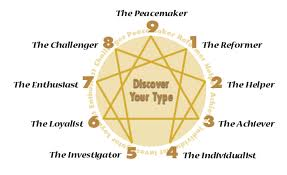A Brief Overview of the 9 Types, and Tips for Growth
Knowing our type correctly is the very first step on a self-discovery journey. Reading a detailed and comprehensive description of the Enneagram type is a good way figuring out our type especially for people who find the descriptions fit their experiences closely. Enneagram Institute founded by Don Riso and Russ Hudson provides a very comprehensive and detailed type descriptions.
Below is just a brief overview of the 9 types, their growth path and a video clip for each Enneagram exemplar:

Type 1 is principled, conscientious, perfectionistic, and self-righteous. They strives to do things right and has a strong sense of right and wrong. They are self-disciplined, improvement-oriented and strive to live up to their high standards, but can also be controlling, rigid, critical and judgemental.
Growth: 1s need to learn to relax, notice and reduce their critical mind, appreciate errors simply as difference, and accept people as who they are, and let their inner wisdom be their guide.
Enneagram Type 1 Exemplar:
Type 2 is concerned, generous, possessive, and manipulative. They need to be needed and valued by helping others. They are loving, caring, helpful and supportive, but can also be needy, prideful, intrusive and pushy.
Growth: 2s need to connect with their own feelings and needs, love others unconditionally for who they are, and don’t expect to be loved and valued by meeting others’ needs.
Enneagram Type 2 Exemplar:
Type 3 is adaptive, ambitious, image-conscious, and hostile. They have a need to be productive, work hard and succeed. They are goal-focused, efficiency-oriented, but can also be competitive, impatient, narcissistic and image-driven.
Growth: 3s need to slow down, learn to appreciate feelings, and be honest with themselves about their achievements, and give their admirations to others.
Enneagram Type 3 Exemplar:
Type 4 is intuitive, creative, self-absorbed, and depressive. They want to explore deep passions and be understood. They are idealistic, creative or expressive and authentic, but can also be dramatic, temperamental, self-absorbed and negative.
Growth: 4s need to appreciate what is positive in life, accept themselves as lovable, stop paying too much attention in their feelings and needs to have a unique identity.
Enneagram Type 4 Exemplar:
Type 5 is perceptive, original, provocative, and paranoid. They seek information and want to understand everything to master the game. They may be wise, open-minded and insightful, but can also be detached, abstract, anti-social and overly private.
Growth: 5s need to realize that withdrawal invites intrusion, and don’t be afraid to share their feelings, and learn to take more constructive action and move forward into life more fully.
Enneagram Type 5 Exemplar:
Type 6 is engaging, responsible, defensive, and paranoid. They have a need for safety and security, and worries about problems and want to be prepared. They are trustworthy, inquisitive, hard-working, reliable and loyal, but can also be overly doubtful, accusatory, anxious, indecisive and reactive.
Growth: 6s need to learn to use their anxiety and come to term with it, notice their preoccupation with danger and projection, become their own authority, and develop greater trust in self and others.
Enneagram Type 6 Exemplar:
Type 7 is spontaneous, accomplished, hyperactive, and excessive. They need to be happy and avoid pain and focuses on new ideas and possibilities. They are fun loving, optimistic, upbeat, lively, but can also be pain-avoidant, unreliable and self-centred.
Growth: 7s need to observe their impulse and lust for experiences, learn to make lasting commitments, and accept everything in life including pain, fear, boredom, limits as well as pleasure, joy, excitement, and options.
Enneagram Type 7 Exemplar:
Type 8 is self-confident, decisive, dominating and combative. They seek to be strong and exercises power to keep control. They are direct, self-confident, powerful, and protective, but can also be domineering, arrogant, aggressive and explosive.
Growth: 8s need to notice their intensity and impact on others, learn to reduce their impulsiveness and don’t take action too quickly, appreciate differences and own their vulnerability.
Enneagram Type 8 Exemplar:
Type 9 is receptive, optimistic, complacent, and resigned. They merge with others to go along and get along to avoid conflict. They are accommodating, good-natured, steady and supportive, but can also be hazy, stubborn, non-responsive and conflict-avoidant.
Growth: 9s need to pay attention to own self and needs, aware of their tendency to go along with others, welcome discomfort and change and be assertive on their own priorities and take action to become an active participant in their world.
Enneagram Type 9 Exemplar:
